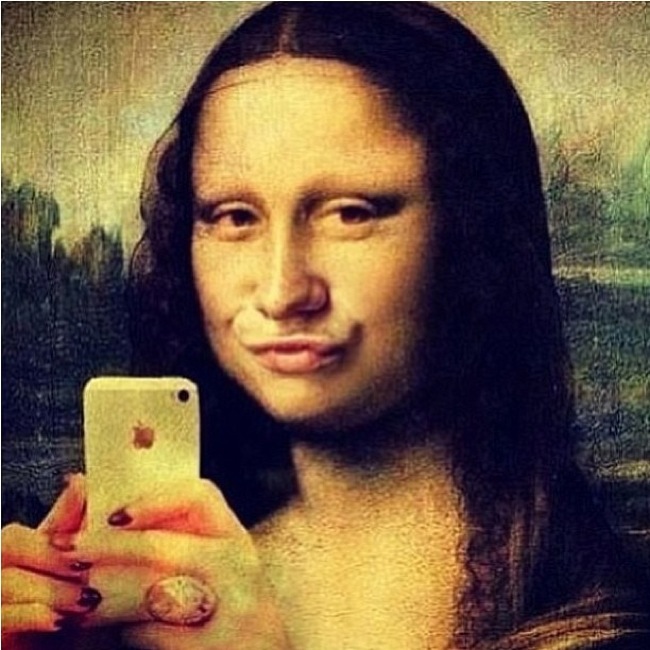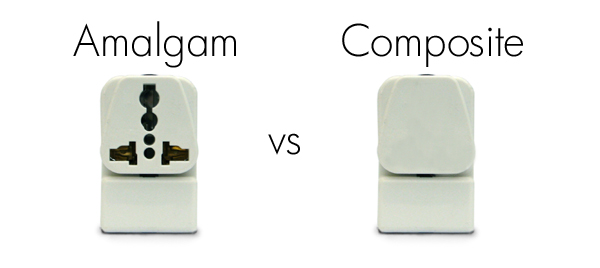
While the majority of dentists now use mercury-free composite fillings, some continue to use dental amalgam, also known as "silver fillings". Over the years, concerns have been raised about the use of amalgam because it contains mercury. Here are answers to some common patient questions about dental fillings.
What is in a mercury-metal filling?
Metal Fillings are composed of mercury, tin, silver (not much), and copper. The actual mercury content is between 43 and 54% mercury when placed. They are not chemically bonded to the tooth as tooth colored, or composite, filling material is. It is the consistency of wet sand when it is placed in a tooth and is only held in by undercutting the tooth structure so it is wedged into place. As time goes by, the filling breaks down in three ways:
- The release of mercury vapor in the mouth lessens the strength, longevity, and resilience of the filling.
- Corrosion of the surface of the filling due to the persistently wet environment. This process is similar to rusting iron.
- Attrition of the surface and edges of the filling from eating, clinching, and grinding cause the edges to be tattered and irregular, causing food traps.
How do mercury-metal fillings work?
When a tooth is prepared mercury-metal filling, healthy portions of the tooth are undercut in order for the filling to stay in the tooth. Essentially, it relies on mechanical retention (it is wedged into place), rather than having a chemical bond and seal to the tooth such as with a tooth colored, or composite) filling.
[caption id="attachment_1586" align="aligncenter" width="584"]
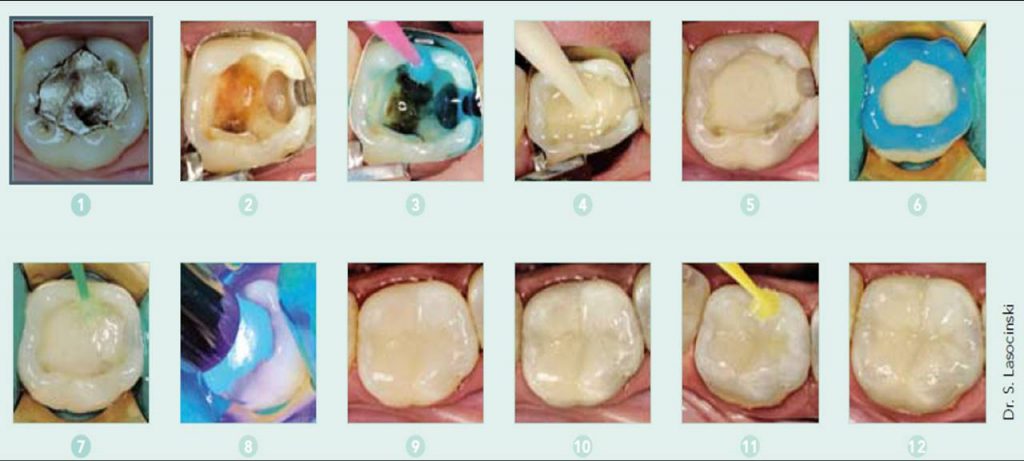
What you can't see: decay often occurs underneath amalgam fillings, and it doesn't always present on x-rays. By removing "silver fillings" and replacing with white composite resin, your dentist will accurately assess any future damage and treat with tiny fillings versus more indepth restorations like crowns, root canals, and/or dental implants.[/caption]
How do these metals affect the tooth?
Metal mercury fillings, without exception, microscopically expand and contract over time (just as mercury does in a thermometer). This causes the enamel of the tooth to fracture over time. Enamel fracture leads to tooth fracture. The more damaged a tooth is, the more expensive it is to repair. The expansion and contraction compromises the seal between the filling and the tooth, allowing cavity causing bacteria to colonize the area below the surface of the filling between the filling and the tooth, eventually causing new cavities.
Cavities beside metal fillings likely grow more slowly than some others because the metals in the filling kill bacteria through exposure. But eventually, the bacteria grow in number enough to overpower the effects of the metals. These new cavities are often difficult to recognize on routine dental x-rays because the metal distorts the view immediately around the filling. But if the margin of the filling is not smooth and perfect, then the cavity forming process has already begun. The new cavities develop over time, possibly causing the tooth the break or facilitating the need for a Root Canal Procedure or an Extraction.
How do metal filings affect your body and overall health?
It has been demonstrated through extensive studies that the amount of mercury released from fillings each day is considerably lower than the amount normally absorbed from the rest of our environmental sources including air, water, and foods. Other studies have demonstrated safety for patients and dental professionals in the removal of amalgam fillings.
[caption id="attachment_1590" align="aligncenter" width="950"]
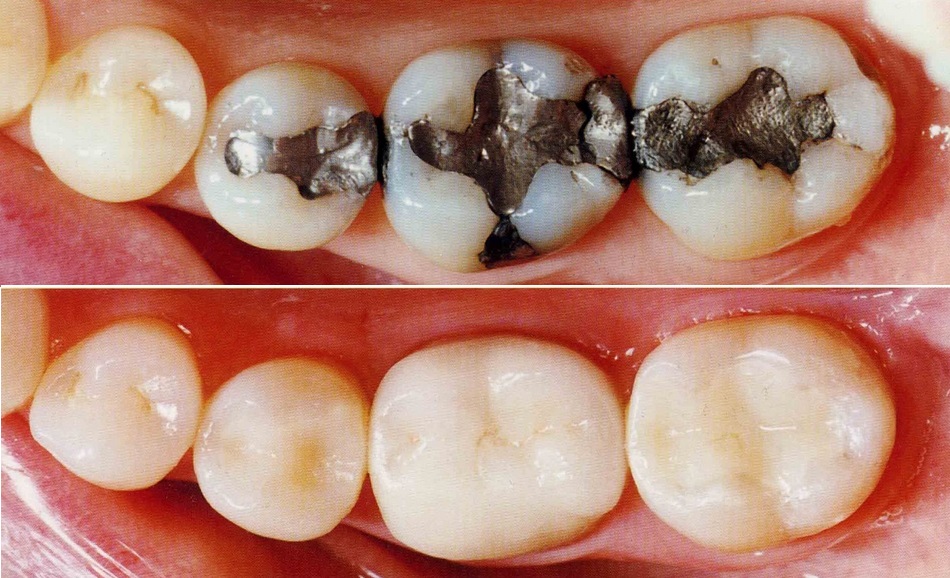
Amalgam v/s Composite Fillngs[/caption]
What do we believe?
We do not believe profound evidence exists showing the mercury is affecting the overall health of most of the individuals who have them. We also find it compelling that if you could actually suffer through reading all of the metal filling related regulations, according to the FDA, EPA, ADA, state governments, and local municipalities, there are only two places where it is acceptable for metal-mercury filling material to exist; Hazardous Waste Disposal, and your mouth. Think about that.
However, we do know with certainty that the amalgams are incredibly detrimental to the health of the tooth. So generally, we believe that if metal fillings are present, they should be removed and replaced with a restoration, porcelain or composite, which will restore the strength of the tooth to last in the long term.
BOTTOM LINE: we remove amalgam fillings because we know (with 99% accuracy) that if the margins are not sealed and they are of a certain age, there is decay destroying the tooth structure below the filling.
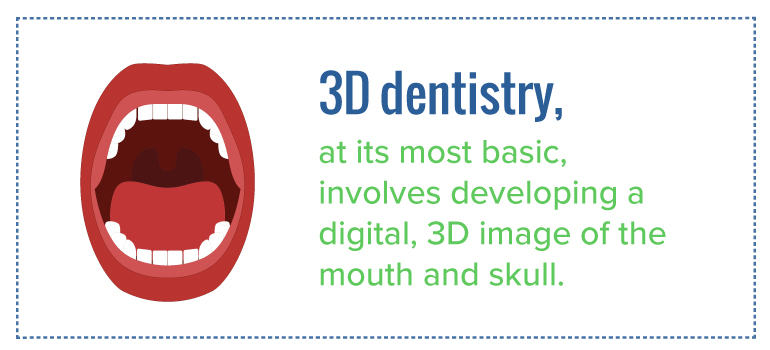 When we think about visiting the dentist’s office, we often think of bright lights, blue bibs, toothbrushes, picks, drills and bubblegum toothpaste. However, advanced imaging utilizing CBCT technology is slowly but surely making its way into dental offices across the United States. Because of their wide recognition as contributors to quality dental care, CBCT machines are now becoming more commonplace among technologically up-to-date offices across the world.
When we think about visiting the dentist’s office, we often think of bright lights, blue bibs, toothbrushes, picks, drills and bubblegum toothpaste. However, advanced imaging utilizing CBCT technology is slowly but surely making its way into dental offices across the United States. Because of their wide recognition as contributors to quality dental care, CBCT machines are now becoming more commonplace among technologically up-to-date offices across the world.
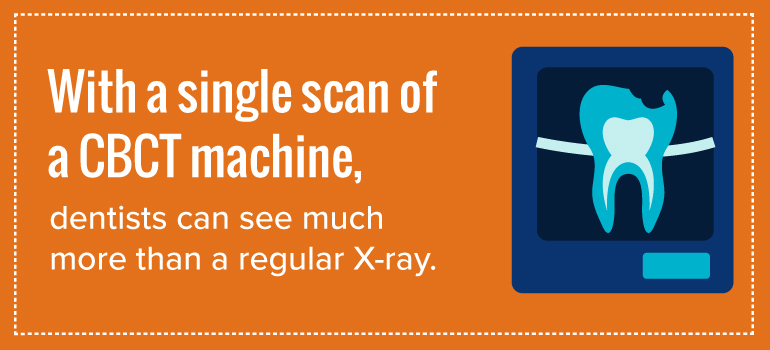 3D dentistry, at its most basic, involves developing a digital, 3D image of the mouth and skull. Traditional X-rays only develop a 2D picture of your mouth, while other methods took longer bouts of radiation to create a detailed picture, and were more unpleasant and intrusive to the patient.
3D dental images are most often used for diagnosis and treatment planning. Being able to see the mouth in three dimensions allows the dentist to better and more effectively formulate an approach to treat dental conditions.
3D dentistry, at its most basic, involves developing a digital, 3D image of the mouth and skull. Traditional X-rays only develop a 2D picture of your mouth, while other methods took longer bouts of radiation to create a detailed picture, and were more unpleasant and intrusive to the patient.
3D dental images are most often used for diagnosis and treatment planning. Being able to see the mouth in three dimensions allows the dentist to better and more effectively formulate an approach to treat dental conditions.

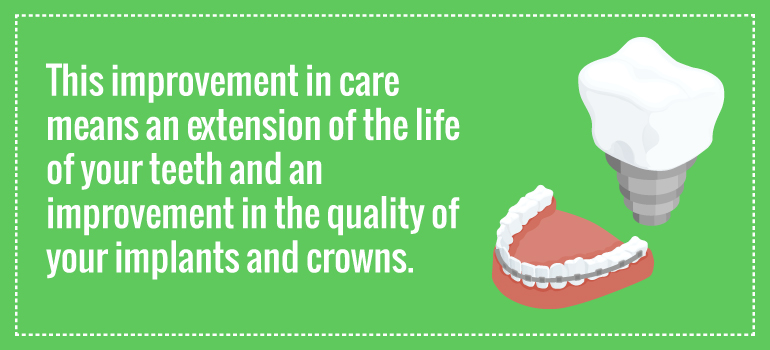

 February is National Children's Dental Health Month, and going to the dentist, as we all know, is an important part of keeping our kids' mouths healthy. Still, it typically doesn't rank very high on any parent or child's "want-to-do" list. Being asked to sit still -- often tipped back in a big chair -- with a bright light in their eyes and someone poking around in their mouth can rattle even the calmest of kids.
Whether your child is mildly nervous or seriously afraid, try these strategies to make visiting the dentist a more positive experience:
Opt for a pediatric dentist. You may be happy with your dentist but a practitioner who specializes in treating kids and adolescents brings extra expertise and experience to the table. Pediatric dentists have an extra two to three years of training beyond dental school so they are experts at managing fearful young patients. In addition, their offices are designed to be kid-friendly. Even little things like outfitting kids with sunglasses to combat the brightness of the lights during an exam or having stuffed animals available for squeezing can help calm nerves.
Start early. The AAPD recommends scheduling your child's first visit as soon as teeth begin to appear or by his first birthday. "An excellent way to minimize anxiety for children is to start regular dental visits before a problem like a cavity develops," says Edward H. Moody, Jr., D.D.S., vice president of the American Academy of Pediatric Dentistry and a pediatric dentist in Morristown, Tennessee. The benefits of early and regular dental care are two-fold: Your child gets into the routine of seeing the dentist while he's still young (and possibly less nervous) and staying on top of any potential problems can cut his chances of needing extensive (ouch!) dental treatment down the line.
Do a meet and greet. Did you know that you can bring your child to the dentist's office to get acquainted before the day of their actual checkup? If kids -- or parents -- are nervous we always recommend that they visit the office prior to their appointment so they can meet the staff, see where they'll sit and find out what to expect during the exam. Coming to the dentist can be a bit of an overload. By visiting first kids can get acclimated and come back another day knowing what to expect. It's a great tool that is completely underutilized.
Get a little bit closer. Having a parent's hand to hold or lap to sit on while getting their teeth checked out can be a big comfort for kids.
But don't do too much talking. Yes, it's tempting to maintain a steady stream of chatter in hopes of distracting your child from the exam (I've been guilty of this!), but resist. Letting the dentist do the talking will help him develop a better rapport with your child, say the experts at the American Academy of Pediatric Dentistry. Have questions? Speak to the dentist after he completes the exam.
Consider scheduling your child's appointments with the same hygienist each time. Often that's the pro who handles a large part of a routine checkup. I've found that always having my kids' cleanings done by their favorite hygienist, Denise, makes the appointments go more smoothly. "For younger children or those who tend to be uneasy around new people or things, seeing the same hygienist may be help build a sense of trust and make the visit more relaxing," notes Dr. Moody.
Make the most of distraction. Many dentists' offices have TV screens playing kid-friendly shows or videos mounted near the exam chair to attract kids' attention. Another option: Ask your child's dentist if she can use your smartphone or MP3 player. Popping in the earbuds and listening to favorite tunes or a book on tape can help take the focus off the dental procedure
Forget your own dental demons. If you dread the dentist, your child can pick up on your feelings. Many parents have their own horror stories: when they come in and see that our office is nice and friendly, that can calm the parent down, which makes the child calmer too.
Run interference if siblings or friends tell scary dentist stories. Is the kid next door detailing the time his dentist yanked on his tooth so hard people could hear him scream from blocks away? Put the kibosh on those types of tales as quickly as possible.
Don't say, "Don't worry. It won't hurt." Of course you mean to reassure your child but his mind is going to zero in on the word hurt. Checkups and 90 percent of first visits are nearly always pain-free, so steer clear of that concept entirely, recommends the AAPD.
February is National Children's Dental Health Month, and going to the dentist, as we all know, is an important part of keeping our kids' mouths healthy. Still, it typically doesn't rank very high on any parent or child's "want-to-do" list. Being asked to sit still -- often tipped back in a big chair -- with a bright light in their eyes and someone poking around in their mouth can rattle even the calmest of kids.
Whether your child is mildly nervous or seriously afraid, try these strategies to make visiting the dentist a more positive experience:
Opt for a pediatric dentist. You may be happy with your dentist but a practitioner who specializes in treating kids and adolescents brings extra expertise and experience to the table. Pediatric dentists have an extra two to three years of training beyond dental school so they are experts at managing fearful young patients. In addition, their offices are designed to be kid-friendly. Even little things like outfitting kids with sunglasses to combat the brightness of the lights during an exam or having stuffed animals available for squeezing can help calm nerves.
Start early. The AAPD recommends scheduling your child's first visit as soon as teeth begin to appear or by his first birthday. "An excellent way to minimize anxiety for children is to start regular dental visits before a problem like a cavity develops," says Edward H. Moody, Jr., D.D.S., vice president of the American Academy of Pediatric Dentistry and a pediatric dentist in Morristown, Tennessee. The benefits of early and regular dental care are two-fold: Your child gets into the routine of seeing the dentist while he's still young (and possibly less nervous) and staying on top of any potential problems can cut his chances of needing extensive (ouch!) dental treatment down the line.
Do a meet and greet. Did you know that you can bring your child to the dentist's office to get acquainted before the day of their actual checkup? If kids -- or parents -- are nervous we always recommend that they visit the office prior to their appointment so they can meet the staff, see where they'll sit and find out what to expect during the exam. Coming to the dentist can be a bit of an overload. By visiting first kids can get acclimated and come back another day knowing what to expect. It's a great tool that is completely underutilized.
Get a little bit closer. Having a parent's hand to hold or lap to sit on while getting their teeth checked out can be a big comfort for kids.
But don't do too much talking. Yes, it's tempting to maintain a steady stream of chatter in hopes of distracting your child from the exam (I've been guilty of this!), but resist. Letting the dentist do the talking will help him develop a better rapport with your child, say the experts at the American Academy of Pediatric Dentistry. Have questions? Speak to the dentist after he completes the exam.
Consider scheduling your child's appointments with the same hygienist each time. Often that's the pro who handles a large part of a routine checkup. I've found that always having my kids' cleanings done by their favorite hygienist, Denise, makes the appointments go more smoothly. "For younger children or those who tend to be uneasy around new people or things, seeing the same hygienist may be help build a sense of trust and make the visit more relaxing," notes Dr. Moody.
Make the most of distraction. Many dentists' offices have TV screens playing kid-friendly shows or videos mounted near the exam chair to attract kids' attention. Another option: Ask your child's dentist if she can use your smartphone or MP3 player. Popping in the earbuds and listening to favorite tunes or a book on tape can help take the focus off the dental procedure
Forget your own dental demons. If you dread the dentist, your child can pick up on your feelings. Many parents have their own horror stories: when they come in and see that our office is nice and friendly, that can calm the parent down, which makes the child calmer too.
Run interference if siblings or friends tell scary dentist stories. Is the kid next door detailing the time his dentist yanked on his tooth so hard people could hear him scream from blocks away? Put the kibosh on those types of tales as quickly as possible.
Don't say, "Don't worry. It won't hurt." Of course you mean to reassure your child but his mind is going to zero in on the word hurt. Checkups and 90 percent of first visits are nearly always pain-free, so steer clear of that concept entirely, recommends the AAPD.
 Because developing good habits at an early age and scheduling regular dental visits helps children get a good start on a lifetime of healthy teeth and gums, February is designated for National Children's Dental Health Month. Now in its 63rd year, this month-long national health observance brings together thousands of dedicated dental professionals, health care providers and others to promote the benefits of good oral health to children and adults, caregivers, teachers and many others.
Untreated dental care remains one of the most prevalent diseases affecting children and young people’s ability to speak, eat, play and socialize. We believe in innovative oral health education so that parents and children understand the impact of sugar on teeth and the importance of a good oral hygiene regime. A few key lessons include:
Teach kids about how sugar impacts their teeth.
We might understand it, but it can be hard for children to understand that the fizzy drinks they’re consuming and the sweets they’re eating are directly impacting their oral health. With very young children, delay introducing sugary drinks as long as possible. If they only have milk and water, they don’t want anything else. As they get older, you can discuss the sugar content of products and make your child aware of the risks. Sometimes it comes down to showing children how much sugar is in their food.
Encourage oral hygiene by example.
Children will understand the importance of tooth brushing if they see their parents taking care of their teeth.
There are a few ways parents can help teach kids that looking after their teeth is important from an early age: make it part of your everyday routine, brush before bed and at one other time during the day. Make sure you have time to do this properly with the children. We often advise that children’s brushing should be monitored until they are seven years old.
We also prefer that parents get children involved as much as possible. Get them to pick a toothbrush with their favorite character, or play their favorite music while they're brushing (there are even apps for this!) There are also mobile games which you can brush along to ‘kill all the bugs’ which help motivate them. A reward chart to track their brushing habits and also diet habits too are great ways of getting them actively involved.
The next big step is to get them to the dentist - something kids can (understandably) get scared about. We'll have tips for calming nerves and preparing your child in an upcoming blog.
Because developing good habits at an early age and scheduling regular dental visits helps children get a good start on a lifetime of healthy teeth and gums, February is designated for National Children's Dental Health Month. Now in its 63rd year, this month-long national health observance brings together thousands of dedicated dental professionals, health care providers and others to promote the benefits of good oral health to children and adults, caregivers, teachers and many others.
Untreated dental care remains one of the most prevalent diseases affecting children and young people’s ability to speak, eat, play and socialize. We believe in innovative oral health education so that parents and children understand the impact of sugar on teeth and the importance of a good oral hygiene regime. A few key lessons include:
Teach kids about how sugar impacts their teeth.
We might understand it, but it can be hard for children to understand that the fizzy drinks they’re consuming and the sweets they’re eating are directly impacting their oral health. With very young children, delay introducing sugary drinks as long as possible. If they only have milk and water, they don’t want anything else. As they get older, you can discuss the sugar content of products and make your child aware of the risks. Sometimes it comes down to showing children how much sugar is in their food.
Encourage oral hygiene by example.
Children will understand the importance of tooth brushing if they see their parents taking care of their teeth.
There are a few ways parents can help teach kids that looking after their teeth is important from an early age: make it part of your everyday routine, brush before bed and at one other time during the day. Make sure you have time to do this properly with the children. We often advise that children’s brushing should be monitored until they are seven years old.
We also prefer that parents get children involved as much as possible. Get them to pick a toothbrush with their favorite character, or play their favorite music while they're brushing (there are even apps for this!) There are also mobile games which you can brush along to ‘kill all the bugs’ which help motivate them. A reward chart to track their brushing habits and also diet habits too are great ways of getting them actively involved.
The next big step is to get them to the dentist - something kids can (understandably) get scared about. We'll have tips for calming nerves and preparing your child in an upcoming blog.
 [Photographs: Vicky Wasik] // image via web[/caption]
Have you heard the latest health & wellness hype that sparkling waters are bad for your teeth? You may have sworn off your Coke and Diet Coke addictions for the good of your health, but if you've switched to flavored waters like La Croix, you might not be making such a great health decision, either.
[Photographs: Vicky Wasik] // image via web[/caption]
Have you heard the latest health & wellness hype that sparkling waters are bad for your teeth? You may have sworn off your Coke and Diet Coke addictions for the good of your health, but if you've switched to flavored waters like La Croix, you might not be making such a great health decision, either.
 image via Unsplash[/caption]
There's nothing like jamming a waxed piece of string between your tightest molars and sliding it back and forth. And who doesn't do that once a day, just as the dentist prescribes?
Well, a lot of us. Twenty-seven percent of adults lie to their dentists about how often they floss their teeth, a
image via Unsplash[/caption]
There's nothing like jamming a waxed piece of string between your tightest molars and sliding it back and forth. And who doesn't do that once a day, just as the dentist prescribes?
Well, a lot of us. Twenty-seven percent of adults lie to their dentists about how often they floss their teeth, a 

 As far as my dental history goes, I've been pretty lucky. My parents always stressed the importance of taking care of my teeth and took me to the dentist on a regular basis. I never had to have braces and didn't even have a cavity for most of my 30s.
Then, as they say, "go big or go home": at 39, I had my first cavity. I didn't even know I had one until my tooth chipped over dinner. An immediate trip to the dentist revealed I not only had a cavity, but I would need a root canal and then a crown. I made it through both those things and thought it was over. I swore to myself I would do a better at staying on top of things and went on with my life.
From the day the crown was placed, it never felt "right": there was always an element of discomfort and my 24/7 awareness that it felt foreign and weird. After the first year, I started feeling more discomfort. Around year two, I began to notice gum inflammation around the crown. Unfortunately, the dentist who did the crown work had gone out of business, so I had to find a new dentist. Many of my downtown/east Nashville friends had recommended Downtown Dental.
Dr. Clark and his team were amazing from my first patient exam. Turns out I not only had a metal allergy to the original crown, but the deep placement of the crown had created significant gum infection. It wasn't the worst news, but as someone who is highly sensitive to antibiotics and tries to go the natural route whenever possible, I didn't look forward to the treatment that would clear up the infection/irritation. Enter "the laser".
I soon happily learned that dentists can use lasers for a host of incredible treatments: not only for bacterial reduction (in this case, for my gums), but for pain management/anesthesia, fillings, tooth contouring/cleaning, and even cold sores. My three laser treatments were quick, absolutely painless, and best of all, I didn't have to take any antibiotics.
The team at Downtown Dental is warm and wonderful, but even better than that, I'm thankful for a dentist who commits to painless technology as treatment versus standard pharmaceutical medication. Turns out there's a better way to do a lot of things without wreaking havoc on the body...even in dentistry.
-D. Carson, 41: Dickson, TN
As far as my dental history goes, I've been pretty lucky. My parents always stressed the importance of taking care of my teeth and took me to the dentist on a regular basis. I never had to have braces and didn't even have a cavity for most of my 30s.
Then, as they say, "go big or go home": at 39, I had my first cavity. I didn't even know I had one until my tooth chipped over dinner. An immediate trip to the dentist revealed I not only had a cavity, but I would need a root canal and then a crown. I made it through both those things and thought it was over. I swore to myself I would do a better at staying on top of things and went on with my life.
From the day the crown was placed, it never felt "right": there was always an element of discomfort and my 24/7 awareness that it felt foreign and weird. After the first year, I started feeling more discomfort. Around year two, I began to notice gum inflammation around the crown. Unfortunately, the dentist who did the crown work had gone out of business, so I had to find a new dentist. Many of my downtown/east Nashville friends had recommended Downtown Dental.
Dr. Clark and his team were amazing from my first patient exam. Turns out I not only had a metal allergy to the original crown, but the deep placement of the crown had created significant gum infection. It wasn't the worst news, but as someone who is highly sensitive to antibiotics and tries to go the natural route whenever possible, I didn't look forward to the treatment that would clear up the infection/irritation. Enter "the laser".
I soon happily learned that dentists can use lasers for a host of incredible treatments: not only for bacterial reduction (in this case, for my gums), but for pain management/anesthesia, fillings, tooth contouring/cleaning, and even cold sores. My three laser treatments were quick, absolutely painless, and best of all, I didn't have to take any antibiotics.
The team at Downtown Dental is warm and wonderful, but even better than that, I'm thankful for a dentist who commits to painless technology as treatment versus standard pharmaceutical medication. Turns out there's a better way to do a lot of things without wreaking havoc on the body...even in dentistry.
-D. Carson, 41: Dickson, TN
 Though the link between dental health and heart health is not completely clear, experts say it’s important to take care of both.
Claiming around 610,000 lives each year, heart disease is the No. 1 killer of both men and women in the U.S.1 Did you know that research has found a link between this deadly disease and the health of your gums?
Having gum disease increases the risk of a first heart attack by 28%, according to a 2016 study by the Karolinska University Hospital in Sweden.2
“Although the findings indicate a strong link between gum disease and heart disease, it’s still unclear whether one actually causes the other,” says the American Heart Association. The two conditions have some of the same risk factors, including smoking, poor nutrition and diabetes. Researchers believe that inflammation caused by periodontal disease may be responsible for the connection.3
Though the link between dental health and heart health is not completely clear, experts say it’s important to take care of both.
Claiming around 610,000 lives each year, heart disease is the No. 1 killer of both men and women in the U.S.1 Did you know that research has found a link between this deadly disease and the health of your gums?
Having gum disease increases the risk of a first heart attack by 28%, according to a 2016 study by the Karolinska University Hospital in Sweden.2
“Although the findings indicate a strong link between gum disease and heart disease, it’s still unclear whether one actually causes the other,” says the American Heart Association. The two conditions have some of the same risk factors, including smoking, poor nutrition and diabetes. Researchers believe that inflammation caused by periodontal disease may be responsible for the connection.3
 While the majority of dentists now use mercury-free composite fillings, some continue to use dental amalgam, also known as "silver fillings". Over the years, concerns have been raised about the use of amalgam because it contains mercury. Here are answers to some common patient questions about dental fillings.
While the majority of dentists now use mercury-free composite fillings, some continue to use dental amalgam, also known as "silver fillings". Over the years, concerns have been raised about the use of amalgam because it contains mercury. Here are answers to some common patient questions about dental fillings.
 What you can't see: decay often occurs underneath amalgam fillings, and it doesn't always present on x-rays. By removing "silver fillings" and replacing with white composite resin, your dentist will accurately assess any future damage and treat with tiny fillings versus more indepth restorations like crowns, root canals, and/or dental implants.[/caption]
What you can't see: decay often occurs underneath amalgam fillings, and it doesn't always present on x-rays. By removing "silver fillings" and replacing with white composite resin, your dentist will accurately assess any future damage and treat with tiny fillings versus more indepth restorations like crowns, root canals, and/or dental implants.[/caption]
 Amalgam v/s Composite Fillngs[/caption]
Amalgam v/s Composite Fillngs[/caption]
